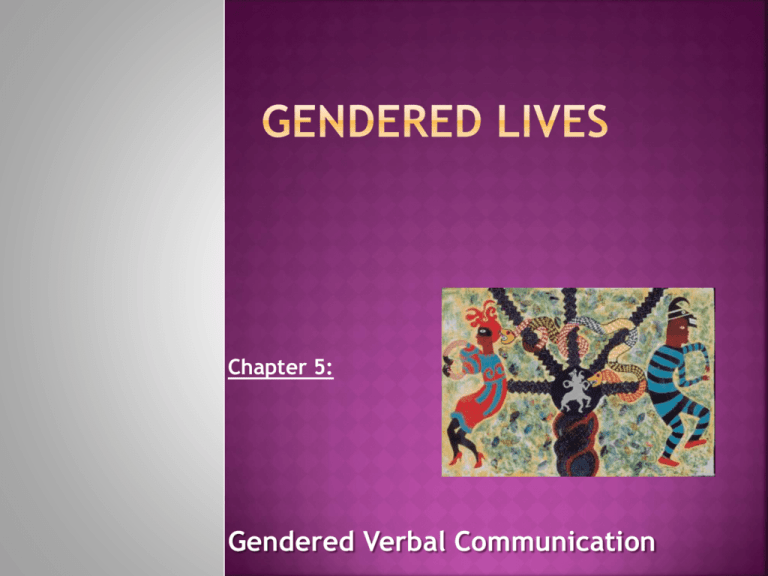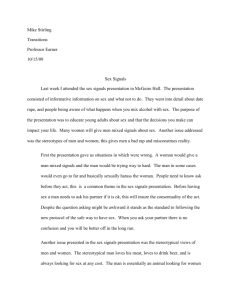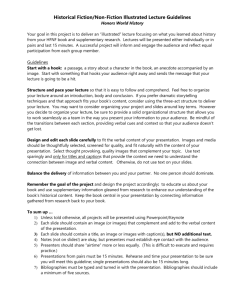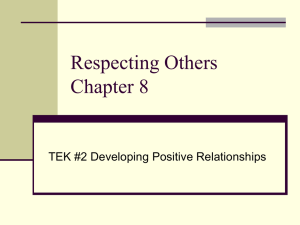PowerPoint - www.micheleweber.homestead.com
advertisement

Chapter 5: Gendered Verbal Communication I. Verbal communication expresses cultural views of gender II. Gendered styles of verbal communication Male generic language excludes women Chairman Spotlighting Highlighting a person’s sex Lady doctor Women defined by appearance or relationship with others Men defined by activities or positions Coverage Focuses more on women’s appearance than skill Coverage of women’s sports of rape or abuse Irrelevant descriptions of victims Language reflects social views of women as passive and men as active in terms of sexual activity Men expected to initiate Language makes that seem acceptable In the past, American unmarried were women called spinsters or old maids In Japan, unmarried women are called leftovers, underdogs, or a parasite single Alternatives to traditional ways of naming ourselves: Some women choose to retain their birth name when they marry Some men and women adopt hyphenated names Matriarchal Naming is important Sexual harassment Date rape Ms. We change our language to change our understandings We reject some terms We create new ones Stereotype - generalization about an entire class of phenomena Women: emotional and weak Men: rational and strong Women who use assertive speech are described as arrogant Men who employ emotional language are described as weak English Queer language encourages polarized thinking performative theory challenges polarized language Language reflects cultural values and has a powerful influence on our perceptions Language devalues females by trivializing women: Equate with food, animals Calling women girls Sexually active women are called derogatory names Androgynous people: Communicate in a range of ways – flexible Higher self-esteem – better adjusted More effective in the workplace Happier marriages Langer (1979) “language sustains cultural life” Labov (1972): a speech community is group of people who share communication norms Males and females are socialized into different speech communities Discussing general differences not absolute Maltz and Boker (1982): Sex-segregated groups remain the norm for U.S. children (2-3 years of age) Boy games Vs. Girl games Competitive Pairs or small groups Clear goals No preset goals and roles Rough play Not highly structured Organized by rules and roles Spend more time talking Boys’ Vs. Girls’ Use communication to: Assert ideas Create relationships Achieve something Attract attention Establish egalitarian relationships Include others Compete for “talk stage” Show sensitivity Girls engage in more cooperative play Boys engage in more instrumental/competitive play Communication rules for men and women are versions of those learned in childhood 1.People socialized in feminine speech communities use language to foster connections 2.Establishing equality is important Match experiences for symmetry 3. Support for others Express emotion Attention to relationship level Questions probe for understanding How does this effect our relationship How do you feel about our decision 4. Conversational maintenance work Efforts to sustain conversation Opens the door to others How was school Do you have anything to add 5. Responsiveness Eye contact, nod, tell me more Affirms other person That’s interesting Encourages elaboration 6. Personal, concrete style Details Personal disclosures 7. Tentativeness Verbal hedges Qualify statements I kind of feel… This is probably a dumb question but ... Tag questions …wasn’t it …you know Seen as representing powerlessness However, reflect desire to keep conversation open 1. Effort to establish status and control Asserting ideas and authority Telling jokes Challenging others More I-references Avoid disclosing information Give advice 2. Instrumentality Problem-solving efforts 3. Women feel men don’t care about feelings Content vs. Relational focus Conversational command Talk more often – greater length Reroute conversations Interrupt more frequently Stage hogging vs. Confirming 4. More forceful and authoritative 5. Direct and assertive More abstract Distanced from personal feelings Deductive vs. Inductive reasoning 6. Less emotionally responsive Minimal response cues May be perceived as lack of involvement Lack of self-disclosure, expressed sympathy May be seen as vulnerable Low context (LC) communication is one in which the mass of the information is vested in the explicit code. High context (HC) communication is one in which most of the information is already in the person, while very little is in the coded, explicit, transmitted part of the message (Hall 1976).










